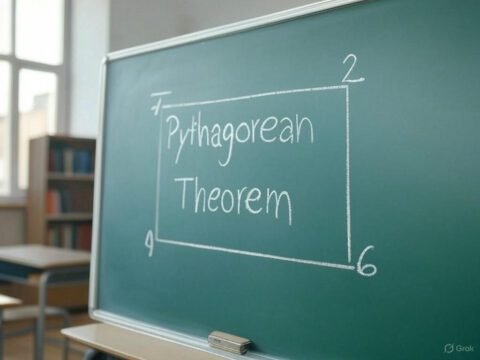🧮 Must-Know ACT Math Formulas: Your No-Fluff Survival Guide
If you’re prepping for the ACT, you’ve probably realized this: they don’t give you a formula sheet.
Unlike the SAT, where certain formulas are handed to you at the beginning of the math section, the ACT expects you to know everything cold.
That’s why learning and memorizing the most important ACT math formulas is not just helpful—it’s essential if you want a top score.
In this guide, we’ll break down:
The must-know formulas by category
Tips to remember and apply them fast
What formulas not to stress about
A downloadable list you can start reviewing now
Let’s go. 🎯
🎓 Do You Really Need to Memorize Formulas for the ACT?
Yes. Here’s why:
You don’t get a reference sheet.
Time is tight: knowing a formula instantly = faster solving.
Many ACT Math questions hinge on simple formula recall.
The good news? You don’t need to memorize hundreds. Just the 30–40 core formulas that show up again and again.
Essential Formulas to Know for the ACT
Master these key formulas to boost your ACT Math score
Quadratic Formula
AlgebraSolve the quadratic equation: 2x² - 5x - 3 = 0
Using the quadratic formula with a = 2, b = -5, and c = -3:
x = \frac{-(-5) \pm \sqrt{(-5)^2 - 4(2)(-3)}}{2(2)}
x = \frac{5 \pm \sqrt{25 + 24}}{4}
x = \frac{5 \pm \sqrt{49}}{4}
x = \frac{5 \pm 7}{4}
x = \frac{5 + 7}{4} = 3 or x = \frac{5 - 7}{4} = -\frac{1}{2}
The solutions are x = 3 and x = -\frac{1}{2}
Slope Formula
AlgebraFind the slope of the line passing through the points (3, 7) and (5, 11).
Using the slope formula with (x₁, y₁) = (3, 7) and (x₂, y₂) = (5, 11):
m = \frac{y_2 - y_1}{x_2 - x_1} = \frac{11 - 7}{5 - 3} = \frac{4}{2} = 2
The slope of the line is 2.
Distance Formula
AlgebraFind the distance between the points (-2, 3) and (4, 7).
Using the distance formula with (x₁, y₁) = (-2, 3) and (x₂, y₂) = (4, 7):
d = \sqrt{(4 - (-2))^2 + (7 - 3)^2}
d = \sqrt{6^2 + 4^2}
d = \sqrt{36 + 16}
d = \sqrt{52}
d = 2\sqrt{13} ≈ 7.21
The distance between the points is 2\sqrt{13} units.
Midpoint Formula
AlgebraFind the midpoint of the line segment with endpoints at (6, -2) and (-4, 8).
Using the midpoint formula with (x₁, y₁) = (6, -2) and (x₂, y₂) = (-4, 8):
Midpoint = \left(\frac{x_1 + x_2}{2}, \frac{y_1 + y_2}{2}\right)
Midpoint = \left(\frac{6 + (-4)}{2}, \frac{-2 + 8}{2}\right)
Midpoint = \left(\frac{2}{2}, \frac{6}{2}\right)
Midpoint = (1, 3)
The midpoint of the line segment is at (1, 3).
Compound Interest
AlgebraIf $2,000 is invested at 6% interest compounded quarterly, what will be the balance after 3 years?
Using the compound interest formula with P = $2,000, r = 0.06, n = 4, and t = 3:
A = P\left(1 + \frac{r}{n}\right)^{nt}
A = 2000\left(1 + \frac{0.06}{4}\right)^{4 \times 3}
A = 2000\left(1 + 0.015\right)^{12}
A = 2000 \times (1.015)^{12}
A = 2000 \times 1.196
A = $2,392
The balance after 3 years will be $2,392.
Area of a Triangle
GeometryA triangle has a base of 8 inches and a height of 5 inches. What is its area?
Using the area formula with b = 8 and h = 5:
A = \frac{1}{2} \times b \times h
A = \frac{1}{2} \times 8 \times 5
A = \frac{1}{2} \times 40
A = 20
The area of the triangle is 20 square inches.
Area of a Circle
GeometryWhat is the area of a circle with a radius of 6 cm?
Using the area formula with r = 6:
A = \pi r^2
A = \pi \times 6^2
A = \pi \times 36
A = 36\pi
A ≈ 113.1 cm²
The area of the circle is 36π or approximately 113.1 square centimeters.
Pythagorean Theorem
GeometryIf a right triangle has legs of lengths 5 and 12, what is the length of the hypotenuse?
Using the Pythagorean theorem with a = 5 and b = 12:
a^2 + b^2 = c^2
5^2 + 12^2 = c^2
25 + 144 = c^2
169 = c^2
c = \sqrt{169} = 13
The length of the hypotenuse is 13 units.
Volume of a Cylinder
GeometryFind the volume of a cylinder with a radius of 4 inches and a height of 10 inches.
Using the volume formula with r = 4 and h = 10:
V = \pi r^2 h
V = \pi \times 4^2 \times 10
V = \pi \times 16 \times 10
V = 160\pi
V ≈ 502.65 in³
The volume of the cylinder is 160π or approximately 502.65 cubic inches.
Surface Area of a Rectangular Prism
GeometryFind the surface area of a rectangular prism with length 5 cm, width 3 cm, and height 2 cm.
Using the surface area formula with l = 5, w = 3, and h = 2:
SA = 2(lw + lh + wh)
SA = 2(5 × 3 + 5 × 2 + 3 × 2)
SA = 2(15 + 10 + 6)
SA = 2(31)
SA = 62
The surface area of the rectangular prism is 62 square centimeters.
Trigonometric Ratios (SOH-CAH-TOA)
TrigonometryIn a right triangle, the hypotenuse is 10 cm and one angle is 30°. What is the length of the side opposite to the 30° angle?
We can use the sine ratio since we need to find the opposite side given the hypotenuse:
\sin \theta = \frac{\text{opposite}}{\text{hypotenuse}}
\sin 30° = \frac{\text{opposite}}{10}
We know that \sin 30° = \frac{1}{2}
\frac{1}{2} = \frac{\text{opposite}}{10}
opposite = 10 × \frac{1}{2} = 5
The length of the side opposite to the 30° angle is 5 cm.
Law of Sines
TrigonometryIn triangle ABC, if angle A = 45°, angle B = 60°, and side a = 12 cm, find the length of side b.
First, find angle C using the fact that angles in a triangle sum to 180°:
A + B + C = 180°
45° + 60° + C = 180°
105° + C = 180°
C = 75°
Now, use the Law of Sines to find side b:
\frac{\sin A}{a} = \frac{\sin B}{b}
\frac{\sin 45°}{12} = \frac{\sin 60°}{b}
b = \frac{12 \times \sin 60°}{\sin 45°}
b = \frac{12 \times \frac{\sqrt{3}}{2}}{\frac{1}{\sqrt{2}}}
b = 12 \times \frac{\sqrt{3}}{2} \times \sqrt{2}
b = 12 \times \frac{\sqrt{6}}{2}
b = 6\sqrt{6} ≈ 14.7 cm
The length of side b is 6\sqrt{6} or approximately 14.7 cm.
Law of Cosines
TrigonometryIn triangle ABC, if a = 8, b = 12, and angle C = 60°, find the length of side c.
Using the Law of Cosines:
c^2 = a^2 + b^2 - 2ab\cos C
c^2 = 8^2 + 12^2 - 2(8)(12)\cos 60°
c^2 = 64 + 144 - 2(96)(\frac{1}{2})
c^2 = 64 + 144 - 96
c^2 = 112
c = \sqrt{112} = 4\sqrt{7} ≈ 10.58
The length of side c is 4\sqrt{7} or approximately 10.58 units.
Special Angle Values
TrigonometryIf sin θ = 1/2, what is the value of cos θ?
We know that sin θ = 1/2, which means θ = 30° (or θ = 150°, but the ACT typically works with angles in the first quadrant unless otherwise specified).
For θ = 30°, we know that cos 30° = \frac{\sqrt{3}}{2}
Therefore, cos θ = \frac{\sqrt{3}}{2} ≈ 0.866
Mean (Average)
StatisticsFind the mean of the following test scores: 78, 84, 92, 65, 89, 72.
Using the mean formula:
Mean = \frac{78 + 84 + 92 + 65 + 89 + 72}{6}
Mean = \frac{480}{6}
Mean = 80
The mean (average) of the test scores is 80.
Median
StatisticsFind the median of the following data set: 12, 5, 22, 19, 8, 15, 27.
First, arrange the data in ascending order: 5, 8, 12, 15, 19, 22, 27
Since there are 7 values (an odd number), the median is the middle value (the 4th value).
Median = 15
Probability
StatisticsA bag contains 4 red marbles, 3 blue marbles, and 5 green marbles. If a marble is drawn at random, what is the probability of drawing a blue marble?
Number of favorable outcomes (blue marbles) = 3
Total number of possible outcomes (all marbles) = 4 + 3 + 5 = 12
P(blue) = \frac{3}{12} = \frac{1}{4} = 0.25
The probability of drawing a blue marble is \frac{1}{4} or 0.25 or 25%.
Standard Deviation
StatisticsWhich data set has a larger standard deviation?
Data Set A: 10, 10, 10, 10, 10
Data Set B: 5, 8, 10, 12, 15
For Data Set A, all values are the same (10), so there is no variation from the mean. The standard deviation is 0.
For Data Set B, the values are spread out from the mean (which is 10), so there is variation. The standard deviation is greater than 0.
Therefore, Data Set B has a larger standard deviation.


